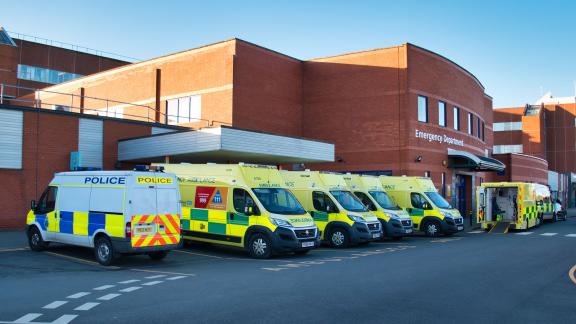What the latest data tell us about ambulance handover delays

While not universal, ambulance handover delays are a widespread and increasing challenge across trusts in England. We take a look at the latest figures, and shine a light on how a whole-system approach in Leeds is addressing the problem.
This analysis is part of our weekly piece looking at the urgent and emergency care situation report (sitrep) review and the monthly performance statistics analysis.
Key points
- Data from the urgent and emergency care sitrep and the Association of Ambulance Chief Executives (AACE) shows ongoing challenges with ambulance handover delays, with delays exceeding 15 minutes accounting for over half of handovers in January 2022.
- Long delays have also been at unprecedented level. During the week ending 20 February alone there were 7,200 over 60 minutes (8.5 per cent of all handovers) and data shows over 15,000 delays over 120 minutes in January 2022 (nearly four times higher than the same time last year). Last week there was a joint intervention from the Care Quality Commission and NHS England and NHS Improvement, with a letter highlighting the need to tackle handover delays.
- We heard from members amidst a varying national picture, including Leeds Teaching Hospitals NHS Trust, that there are common themes in trusts that have proactively tackled ambulance handovers, including taking ownership of the patient; strong relationships between local partners; sharing data; leadership; taking a zero-tolerance approach and tackling other challenges related to patient flow.
The NHS standard contract states that all handovers of patients between ambulances and A&E must take place within 15 minutes, with none taking more than 30 minutes. The clock begins when an ambulance arrives outside an A&E department and stops when a clinical handover has been fully completed to A&E staff.
Long delays to these handovers have been at a record high throughout this winter, with 17,778 over 30 minutes and 10,586 over 60 minutes in week ending 20 February alone. The volume of hours lost to handover delays over 60 minutes rose 938 per cent between February 2021 and January 2022. These can cause potential harm to patients, as shown by the Association of Ambulance Chief Executives report released in November 2021. It found that more than eight in ten patients who were delayed beyond 60 minutes were assessed as potentially having experienced some level of harm, and that nearly one in ten experienced severe harm.
Further to this, delayed handovers result in poorer ambulance response times, as ambulances sit queuing outside of A&E departments unable to attend patients waiting in the community. Not only does this increase pressure on clinical staff, it also causes pressure on ambulance call handlers, as distressed patients and their families call to get updates on their wait time. This can lead to thousands of additional (duplicate) calls, placing even more pressure on ambulance services.
Handover delays are not an ambulance issue, they are a whole-system issue impacted by challenges elsewhere in the system, particularly with hospital capacity and patient flow. This includes delayed discharges to social care and other services, as well as bed occupancy. As such, a whole-system approach is needed to tackle them.
Last week, the Care Quality Commission and NHS England and NHS Improvement (NHSEI) intervened with a letter to trust and system chief executives, outlining the need for this whole-system approach to tackling challenges across the urgent and emergency care pathway, including handover delays. This was the latest in a steady stream of letters and calls to tackle handover delays, yet they persist. However, handover delays are not an insurmountable problem; some areas have managed to effectively tackle handover delays, recognising the risk to patients in the community and those waiting outside an A&E by seeing them as their own patients.
Latest data
Data from the Association of Ambulance Chief Executives shows that handover delays exceeding 15 minutes (the national standard) accounted for over half of handovers in January 2022, with hours lost due to these handovers as high as 114,000 in one month. For comparison, in January 2021 this was 69,000 hours, and in January 2020 67,000.
The weekly data from today’s sitrep shows that there were 84,584 ambulance arrivals to A&Es in week ending 20 February. Within those arrivals, 17,778 handovers were delayed over 30 minutes (21 per cent) and 7,192 over 60 minutes (8.5 per cent). Last week there were 85,513 arrivals, with 17,063 delays over 30 minutes (20 per cent) and 6,855 over 60 minutes (8 per cent), so performance has declined slightly this week.
Below is a comparison of handover delays over 30 minutes in the winter of 2021/22, compared to the previous two winters:
There is not a clear correlation this winter between increasing volume of ambulances arriving and handover delays increasing, with the difference in national arrivals varying by 4,378 (between 81,135 per week and 85,513) and the big drop in handover delays in the week leading up to Christmas:
The below chart shows the significantly higher numbers of handover delays over 60 minutes compared to the last two years:
Data from the Association of Ambulance Chief Executives (AACE) also shows the scale of challenges with long handovers. The volume of handovers exceeding 120 minutes was over 15,000 compared to less than 4,000 in January 2020 and 5,600 in January 2021, and ten times higher in January 2022 when compared to February 2021.
The latest monthly data also shows challenges with ambulance response times, exacerbated by handover delays. In January, the average response time for a category 1 incident (where an immediate response is required to a life-threatening condition such as a cardiac arrest) was 8 minutes and 31 seconds. Although this is an improvement from the four preceding months, which were all over 9 minutes, the average across 2019 for comparison was 7 minutes and 12 seconds, and the ‘standard’ is 7 minutes.
This is even more pertinent for category 2 incidents, which include strokes and require rapid assessment and/or urgent transport and the standard is 18 minutes. In January this was over 38 minutes, and it passed 50 minutes in October and December. Although the standard was not regularly met pre-pandemic, the average across 2019 was still 23 minutes.
Regional picture
The chart below shows the percentage of ambulances delayed over 30 minutes from region to region, with the south west having 36.2 per cent of handovers delayed by 30 minutes or more in the week ending 20 February. This is significantly more than other regions: in the south east this is 12.4 per cent and in London 14.1 per cent.
Many of these have been long delays, too. The latest data for the south west shows as many as 24.2 per cent of handover delays over 60 minutes across the week, when the national average was 8.5 per cent.
There are a number of reasons why this might be the case. Rural and coastal regions have a much lower capability to divert ambulances to other hospitals when under pressure compared to other regions, due to the significant distances between emergency departments. Members have been reporting high bed occupancy and challenges with patient flow, particularly in the south west and midlands. As the south west is the ambulance service covering the most rural region in England, ambulance response times are often challenged due to the lower population density and longer distances to travel.
Member feedback
There are some common themes with trusts that have proactively tackled ambulance handovers, including taking ownership of the patient; strong relationships; sharing data; leadership and taking a zero-tolerance approach; and tackling wider issues around flow.
Case study: Leeds Teaching Hospitals NHS Foundation Trust
Leeds Teaching Hospital NHS Trust has had one of the lowest rates of handover delays in the country. The trust works hard with Yorkshire Ambulance Service (YAS) to build a positive culture and take over patient care as soon as possible, accepting ownership of the patient as soon as they enter the hospital site.
Last week, 4.9 per cent of handovers at Leeds Teaching Hospitals were over 30 minutes, compared to 21 per cent nationally, and just 0.16 per cent over 60 (8.5 per cent nationally). In January, their sites achieved 99.6 per cent and 99.9 per cent of handovers within one hour.
The trust outlined to us that collaborative working and taking a whole-system approach are key. The trust has a zero-tolerance approach to ambulance handover delays, which is owned by staff across the department and recognised by colleagues throughout the organisation, from the clinicians in the emergency department to the CEO. Through well designed processes, the sites have a dedicated hospital ‘ambulance team’ staffed by two nurses at all times, with one nurse checking in with the ambulance crew and taking responsibility of the patient from the clinician, and a second doing further assessment, observations and allocating where the patient will go.
The trust also has a robust escalation process they can implement when needed and can pull in staff quickly to help create space for incoming patients.
NHS Confederation viewpoint
- Ambulance handover delays are not an ambulance issue, they are a whole-system issue and require a whole-system response. Systems need to understand what ambulance handover delays are telling them about their system, as well as the risks to patients, particularly the ‘unseen’ patients waiting in the community. Systems should have handover delays in their risk registers and work with all system partners to mitigate those risks.
- The data shows us that handover delays are not a universal issue. When looking at trusts with a similar volume of ambulance handovers, some trusts have less than 5 per cent delayed over 30 minutes and others over 40 per cent. There are some common themes with trusts that have proactively tackled ambulance handovers, including taking ownership of the patient; strong relationships; sharing data; leadership and taking a zero-tolerance approach; and tackling wider issues around flow. Some trusts have got their approach right – it’s a long-term problem to resolve nationally but it isn’t impossible to improve on locally in the short term either.
- Ambulance handovers cannot be solved in isolation, they are a symptom of wider issues and as a result need to be tackled in conjunction with other system issues, including demand management, the interface with primary care, risk management and patient flow across the whole system.
How is the NHS performing this winter? 14 to 20 February
Both discharge and bed occupancy, as indicators of patient flow, are regularly cited as issues increasing the number of ambulance handover delays as trusts struggle to free up space for new arrivals.
Discharges
On an average day during week ending 20 February, 11,790 patients remained in hospital despite being medically fit to be discharged. This is slightly better than last week (12,168), although in percentage terms there was a decrease in the number of patients successfully discharged each day, which was 9,425 of 21,593 in the previous week (43.6 per cent) compared to 9,069 of 20,859 in the latest data (43.5 per cent).
The chart below shows that the percentages of medically fit patients successfully discharged have slightly decreased since the start of December, despite the extensive efforts of NHS organisations to improve patient flow.
These medically fit patients still make up approximately 14 per cent of the total patients in beds in England, highlighting the continued issues with discharging to the community, other NHS services, social care and mental health settings. We focused on delayed discharges earlier this month, looking at the overall picture this winter.
Bed occupancy
Last week we focused on bed occupancy and how the NHS tends to ‘run hot’ in comparison to other health systems, with general bed occupancy heading back towards pre-pandemic levels having decreased last winter.
This week, total general and acute (G&A) bed occupancy was 92.3 per cent, remaining steady but still at a high level. The below chart shows the comparison of occupancy percentages to previous years:
In the south west, total G&A bed occupancy was over 95 per cent, well above the national average, and backing up information from members this week that high bed occupancy is one of the causes of ambulance handover delays.
Adult G&A occupancy nationally was 93.7 per cent (93.6 per cent last week), while adult critical care averaged 75.2 per cent occupancy (3,044 of 4,048 beds occupied). A comparison to the same time last year shows lower occupancy this year (77.4 per cent were occupied in week 7 of 2021), with 4,441 of 5,739 beds occupied on an average day. More patients were being admitted with COVID-19 at the same time last year, and the use of mechanical ventilation beds for the seriously ill was also considerably higher.
Absence
Following high absence during the peak of the Omicron wave, this problem has reduced. However, it is still unwelcome and unusually high, coinciding with seasonal pressures, high bed occupancy and the elective backlog present challenges.
In the week ending 20 February, 17,250 staff were absent on an average day nationally. This accounts for 30 per cent of all absences (total average is 58,292). In the previous week, there were 62,777 absences, of which 34 per cent were due to COVID-19 related reasons (21,325).
For context, at one point this winter, the seven-day average of COVID-19 absences was as high as 45,741 and accounted for over half of all absences.



